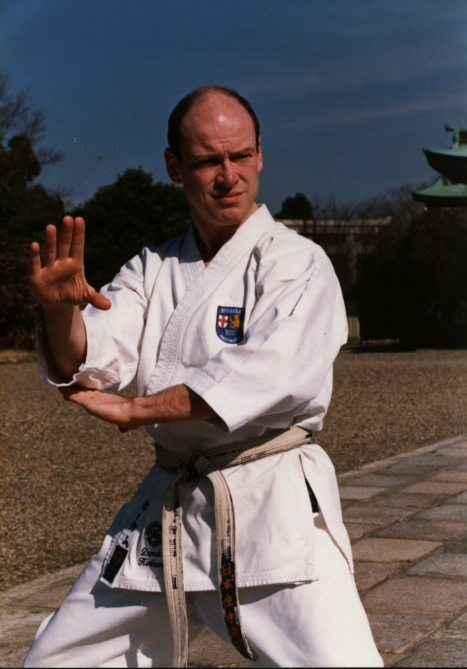"Coaching The SKU Way!" Official SKU Coaching Resource
February 2012 Issue 46 SKU Quarterly Magazine
What does Karate Kata mean to you ?
by Derick Kirkham
What is the meaning of Kata? What’s it all about? What’s the point of it? having gone into print and been asked this question many times over the years by many people, members of the general public who don’t train, novice students, advanced students, teachers of the subject, Kumite specialists, Kata specialists, sport only karate-ka, self-defence enthusiasts, petty politicians in Karate, pundits who are deliberately trying to be controversial, heads of other associations, practitioners of other style of Martial Arts, mean spirited individuals who are just looking for loop holes who have an axe to grind, candidates for a promotional exam, Japanese cultural enthusiasts, Karate historians, traditionalists and modernisers and I have given a wide range of answers to the same question. Not because I was constantly changing my opinion, but my answer is dependent upon the recipient of the message, their motivation for asking, their area of interest and what is their level of experience.
However, I believe, that many of them meant to ask me, "What does Kata mean to you?" Now that would have got them a completely different answer.
I feel that whatever the person believes to be true about Kata, may well be as valid of an explanation as the next man’s interpretation. As long as the person who practices Kata gets something in exchange for them holding their particular belief, and that the return on investment is reflected in an enhancing of their experience of and their practice and final performance of the Kata!
Kata is part of the physical culture of Karate; it is a Japanese term meaning shape or form. Kata all have individual names and are of a set number of basic techniques in length and all techniques are arranged to appear in a specific order. Although different styles of Karate use different names to describe the same Kata and some styles prefer to retain the Chinese or Okinawan names, nevertheless they are recognisable as being of the same Kata.
Kata are like a Martial war dance, similar in nature to the New Zealand "HAKA", they are akin to shadow boxing, gymnastics floor routines. They are aesthetic in appearance but definitely Martial & warlike by nature. Kata are generally practiced alone and are a rehearsal fighting routine, but they do not realistically portray an actual fight scenario. That isn’t to say that individual techniques or mini sequences of techniques taken from Kata are unworkable, because they do work! But not necessarily in the format that they are presented when accumulatively performed. They are a library of basic Karate technique put together in a series of combinations but they do not represent one continuous fight event. The idea that each Kata are a series of techniques against four or eight imaginary opponents is held by many, although it is highly unlikely. However, if it helps the student at the early stages of their development to conceptualise that belief, and benefits them in the execution of their performance, Instructors should therefore, have no problem whatsoever, with them holding fast to that idea.
Despite some Kata being recent inventions, of 50 years old, the majority however, are much older, several generations older. There are some people, who gain great strength and enjoyment from the experience of the Kata performance when bearing in mind the historical & traditional aspects of the Kata, how they have been handed down, generation to generation through instructors and passed on to their students unchanged.
In reality, it is known that the Kata which Funakoshi taught when he moved to Japan from Okinawa was performed by him differently to the way that he was taught them, and in turn Nakayama taught them differently to the way that Funakoshi taught him, and Kanazawa also teaches them with slight nuanced differences to the way that Nakayama taught him. Nevertheless, the Kata are a link to the past and therefore, for me they are even more enjoyable for that reason.
An important factor to remember is that, Kata is not a punishment beating for the performer, so whatever ones motivation to practice Kata may be, it is of paramount importance to the performer that they enjoy the experience even if they only perform the Kata merely as a means of physical exercise, and they are performed with no traditional appreciation whatsoever.

Derick Kirkham 7th Dan Performing Gojushiho Sho in Kyoto Japan
Once a version of the Kata has been chosen for study, and a specific theme or concept has been accepted and allocated to it, practice it not to display that concept as the primary goal. Perform it initially to achieve technical excellence in the delivery of the techniques themselves and then as secondary aim perform the Kata to express the elegance of the systems techniques and to execute them with Martial intent. Kata is part of the physical culture of Traditional Karate-do therefore its practice and performance should be one of a personal growth experience. Kata is a form of Moving Zen, a Martial routine, something that allows one to gain a focused state, albeit for the duration of the performance. It
allows one to block out the everyday worries of one’s life and channelling ones concentration elsewhere in a positive manner. And if one performs it well and the viewer understands the broader message/concept that one is trying to purvey and they also can appreciate the effort, time and levels of hard work that has gone into delivering that one performance, then that in itself is a bonus but should never be the aim. Perform Kata with the initial intent of YOU being the main beneficiary.
Good Luck and Good Practice.
